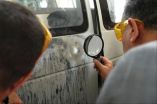(Press-News.org) Some Parkinson's Disease patients can suddenly become creative when they take dopamine therapy, producing pictures, sculptures, novels and poetry. But their new-found interests can become so overwhelming that they ignore other aspects of their everyday life, such as daily chores and social activities, according to research published in the March issue of the European Journal of Neurology.
Italian researchers studied 36 patients with Parkinson's Disease - 18 with increased artistic production and 18 without - and compared them with 36 healthy controls without Parkinson's. None of the patients had engaged in artistic hobbies before they took dopamine.
"Patients were included in the artistic group if they started working on creative projects for two or more hours a day after starting taking dopamine" explains lead author Dr Margherita Canesi, a neurological specialist at the
Centro Parkinson e Disordini del Movimento in Milan.
"Our findings suggest that the patients' newly acquired artistic skills were probably there all along, but did not start to emerge until they took the dopamine therapy. They did not appear to be connected with abnormal repetitive behaviours, such as impulse control disorders or punding - stereotyped behavior characterised by an intense fascination with a complex, excessive, non-goal oriented, repetitive activity.
"Other researchers have noted that altered creative drive has been observed in patients who have neurodegenerative diseases or have had a stroke. However the anatomical and physiological understanding of creativity is difficult to establish and quantify."
Dopamine is a neurotransmitter that helps control the brain's reward and pleasure centres. It helps to regulate movement and emotional responses and enables people to see rewards and work towards them. Parkinson's Disease is caused by dopamine deficiency and using medication to increase dopamine levels in the brain is one of the most popular kinds of therapy.
Key findings of the study included:
The artwork presented by the patients was mainly drawings/paintings (83%), poetry/novels (50%) and sculpture (28%). In 78% of cases, the patients showed more than one skill, normally writing plus painting or drawing.
Some of the patients produced art that was sold and books that were published, but, at the other end of the scale, some of the creative work was of a very poor quality.
By using the Torrence Test of Creative Thinking to compare the three groups, the researchers showed that the artistic Parkinson's Disease patients had similar overall and individual scores to the healthy controls. However the non-artistic patients had significantly lower overall scores than the healthy controls and significantly lower scores than the artistic patients when it came to the elaboration sub-score.
There was no correlation between the Torrence Test of Creative Thinking scores and the scores obtained using the Barratt Impulsivity Scale, one of the oldest and most widely used measures of impulsive personality traits.
The researchers also used the Minnesota Impulsive Disorders Interview. This showed that one creative patient was positive for compulsive sexual behaviour, one creative patient for compulsive buying and two creative and three non-creative patients for pathological gambling. However, there was little difference in the Torrence scores for patients who tested positive or negative on the Minnesota scale.
None of the patients or healthy controls displayed the stereotyped behaviour measured by the Punding Rating Scale.
"In conclusion, we found that newly acquired creative drive in patients with Parkinson's Disease, after the introduction of dopaminergic therapy, is not related to impulsivity or impulse control disorders as measured by the Barratt Impulsivity Scale or the Minnesota Impulsive Disorders Interview" says Dr Canesi.
"We believe that their desire to be creative could represent emerging innate skills, possibly linked to repetitive and reward-seeking behaviours. Further studies are needed to support our preliminary observations."
###
Notes to editors
Artistic productivity and creative thinking in Parkinson's disease. Canesi et al. European Journal of Neurology. 19, pp468-472. (March 2012) doi:10.1111/j.1468-1331.2011.03546.x
The European Journal of Neurology covers all areas of clinical and basic research in neurology, including pre-clinical research of immediate translational value for new potential treatments. Emphasis is placed on major diseases or large clinical and socio-economic importance (dementia, stroke, epilepsy, headache, multiple sclerosis, movement disorders, and infectious diseases). The journal provides a forum for European activity in clinical neuroscience and medical practice and helps strengthen the links between research workers and clinicians in Europe and other parts of the world. The journal also publishes the official EFNS taskforce papers. http://wileyonlinelibrary.com/journal/ENE
Wiley-Blackwell is the international scientific, technical, medical, and scholarly publishing business of John Wiley & Sons, with strengths in every major academic and professional field and partnerships with many of the world's leading societies. Wiley-Blackwell publishes nearly 1,500 peer-reviewed journals and 1,500+ new books annually in print and online, as well as databases, major reference works and laboratory protocols. For more information, please visit www.wileyblackwell.com or our online platform, Wiley Online Library (wileyonlinelibrary.com), one of the world's most extensive multidisciplinary collections of online resources, covering life, health, social and physical sciences, and humanities.
END
To connect a laptop to an additional monitor, projector or even to a monitor wall, a special cable was required, until now. Researchers of the Saarland University's Intel Visual Computing Institute overcome this obstacle by linking computer and monitor via an 'Internet Service'. By this means, a screen's contents can be shifted freely to any terminal's display and even shown on large-scale monitor walls. The Saarland University's scientists present their results for the first time at stand F34, in hall 9 at the computer fair Cebit. The trade show takes place in Hannover ...
A study in Spain shows that insecurity at work is directly and negatively linked to satisfaction in work and life, as well as affecting performance and commitment. Furthermore, the research reveals that the consequences of this insecurity are different according to the occupational group they work in.
A study led by Spanish psychologists has concluded that the feeling that one is going to lose their job worsens satisfaction levels in other areas of life, such as family, health, financial circumstances and the work-free time balance.
As the fear of unemployment increases ...
Bisphenol A (BPA) is a controversial chemical widely used in the plastics industry. A new study followed people over a 10-year time period and shows that healthy people with higher urine concentrations of BPA were more likely to later develop heart disease.
The study was carried out by researchers at the Peninsula College of Medicine and Dentistry, the University of Exeter and the European Centre for the Environment and Human Health, in association with the University of Cambridge. The analysis was funded by the British Heart Foundation. The paper is published online ...
In an exclusive interview with Physics World, astronaut Drew Feustel gives a vivid account of his two missions into space and recalls his determination to make his childhood ambition – space flight – come true.
In the video, Feustel discusses his two missions – his maiden flight in 2009, as part of a team sent to repair the Hubble Space telescope, and his return to space in 2011 as the lead spacewalker on Endeavour's final mission to the International Space Station.
Recalling the first moments of launch, when you're sitting on the launch pad and the countdown hits ...
Researchers at the universities of Granada and Jaén, Spain, have discovered why recalling some items from memory reduces our ability to recall other related items. In the field of Psychology, this phenomenon is known as "Retrieval-Induced Forgetting" (RIF), and researchers have determined the cognitive process that causes this phenomenon and its duration.
To carry out this study, the researchers designed a set of memory tasks where the participants had to learn a material and then recall it partially. Memory tasks had different levels of difficulty and included different ...
A 28-year comparative study of wild emmer wheat and wild barley populations has revealed that these progenitors of cultivated wheat and barley, which are the best hope for crop improvement, have undergone changes over this period of global warming. The changes present a real concern for their being a continued source of crop improvement.
Wheats and barleys are the staple food for humans and animal feed around the world, and their wild progenitors have undergone genetic changes over the last 28 years that imply a risk for crop improvement and food production, reveals a ...
Is there such a thing as a typical criminal career? This was the question addressed by criminologist Volker Grundies from the Max Planck Institute for Foreign and International Criminal Law in Freiburg. This study examined the data of approximately 21,000 men from Baden-Württemberg, who had come into conflict with the law on one or more occasions. The results of his study challenge widely held criminological theories surrounding the development of delinquent behaviour in the life of an individual.
In this project, Grundies and his colleagues at the Freiburg-based Institute ...
A new report by the National Institute of Standards and Technology (NIST) and the Department of Justice's National Institute of Justice (NIJ) has documented 149 potential sources of human error in the analysis of crime scene fingerprints. The study by a working group of 34 experts recommends a series of improvements to significantly reduce or eliminate the errors, based on the findings from its three-year scientific assessment of the effects of human factors on forensic latent print analysis. The working group consisted of experts from various forensic disciplines, statisticians, ...
Cogent Road, a provider of innovative cloud-based mortgage technologies, has introduced GravityTM, the first mortgage-specific CRM/Lead Management System that helps loan officers obtain a loan commitment in a single call.
Gravity is the only cloud-based CRM/lead management system fully integrated with credit, 1003, FHA Scorecard, a pricing engine (Price My Loan), loan comparison tools and anti-steering disclosure, allowing loan originators to take a complete application, select and price a loan, accurately discuss financial benefits and qualify borrowers in one call. ...
WASHINGTON, Feb. 23, 2012 – National results indicate that tree cover in urban areas of the United States is declining at a rate of about 4 million trees per year, according to a U.S. Forest Service study published recently in Urban Forestry & Urban Greening.
Tree cover in 17 of the 20 cities analyzed in the study declined while 16 cities saw increases in impervious cover, which includes pavement and rooftops. Land that lost trees was for the most part converted to either grass or ground cover, impervious cover or bare soil.
Of the 20 cities analyzed, the greatest percentage ...



